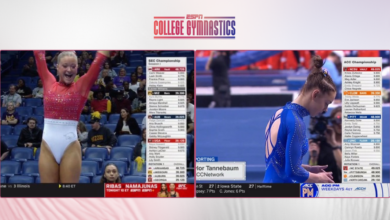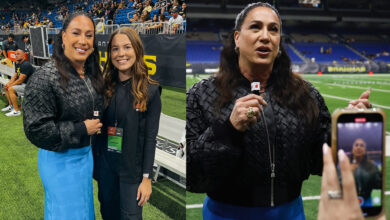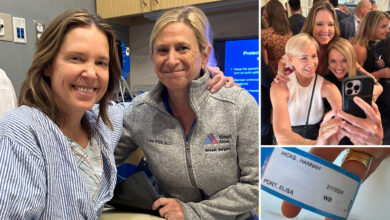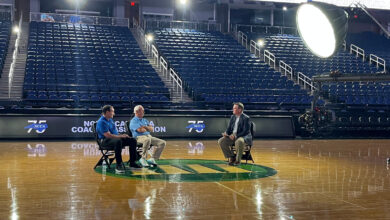MNF steadicam operator Phil Jacques carries 40 pounds of equipment to deliver great pictures
The people who operate the different types of cameras on ESPN’s Monday Night Football all have unique roles similar to the specialized equipment they use.
In the case of MNF steadicam operator Phil Jacques, that is especially true.
Jacques — who will be on the field for tonight’s New York Jets versus Tennessee Titans game (8:30 p.m. ET, ESPN) — is the person fans often see running alongside the players with a 40-pound camera attached to his body. The perspective his steadicam offers provides fans with arguably the most intimate in-game look at NFL players.
A seven-year veteran of MNF, Jacques will finish out the Monday Night schedule this week before moving onto the 2013 Rose Bowl and other assignments. Already this year, Jacques has also covered College GameDay (basketball), the NFL Draft, the MLB Home Run Derby and Major League Soccer.
In the video above, Jacques explains how the steadicam set-up works. Below, he answers more questions about his experiences.
Describe your job on Monday Night Football?
My job is to cover on-the-field shots. The league allows us on the field with a steadicam to cover scoring plays and other shots when the play clock and game clock are stopped. I spend the entire game looking at down, distance and time on the clock and scenarios for each team, and I try to do my best to judge what may or may not happen. I am moving constantly for the three hours of the game.
What’s it like to be so close to the game action?
It’s probably one of the best seats in the house. I’m lucky to be able to be that close to the players. I don’t think most people ever get that close to the action during a game. So, it’s a little nerve-wracking at times, especially early in the season. If I haven’t done it in a while, then I’m concerned about the speed and the size of the players, but the more games we do, the more comfortable I feel.
Have you ever been injured?
Never. I’ve managed to avoid a lot of close calls. It’s just being lucky. You really have to pay attention to what’s going on and not get caught watching the game.
What’s the most difficult part of the job?
Getting from A to B. . . it’s not getting the shots, it’s getting in position to get to the shots and trying to figure out what happens because we don’t know what happens play to play.
How do you know if you’ve been successful at the end of the game?
If I have a variety of shots that cover the offense, the defense, and I’m able to show fans’ reactions and emotions, then I know we’ve documented as much as we can on the field.







